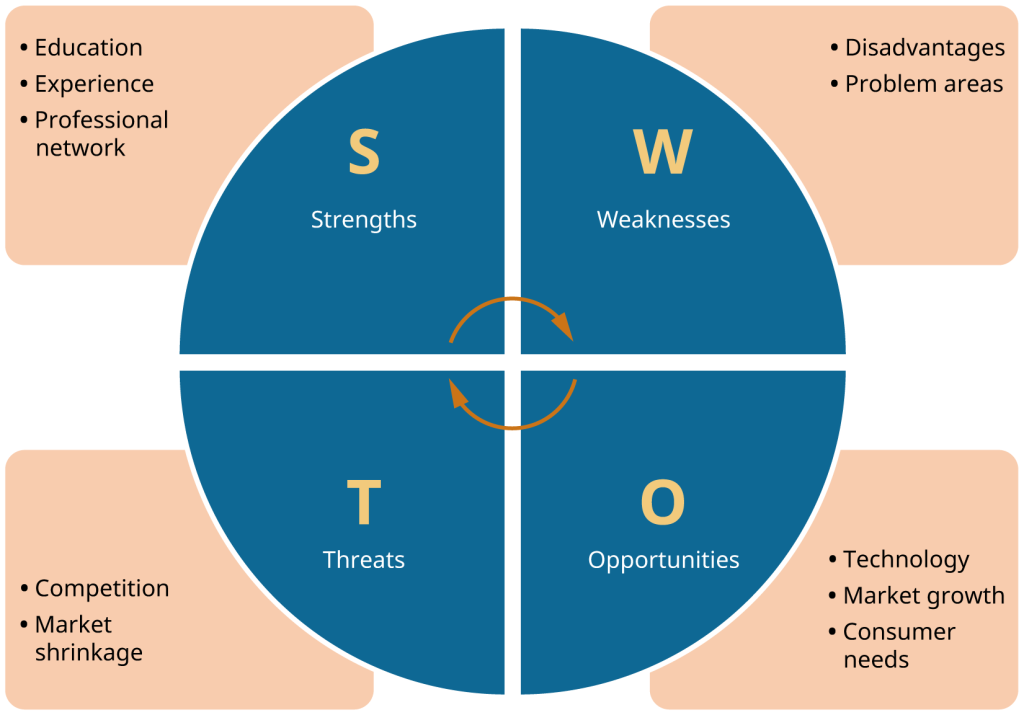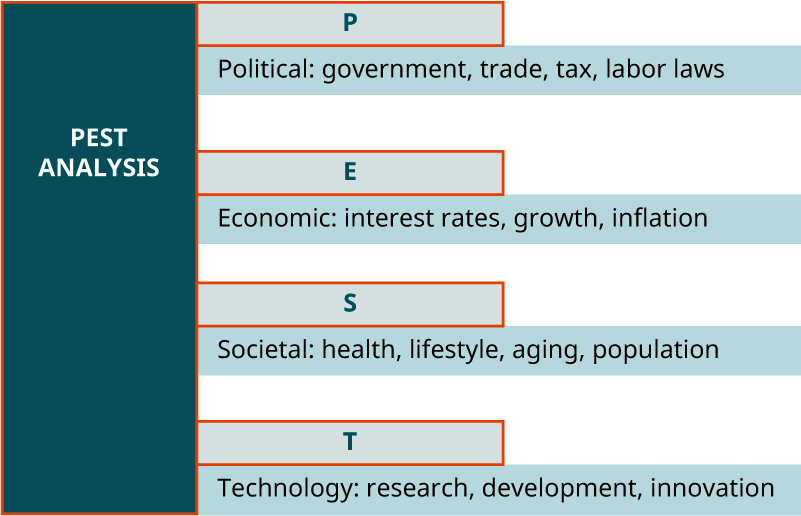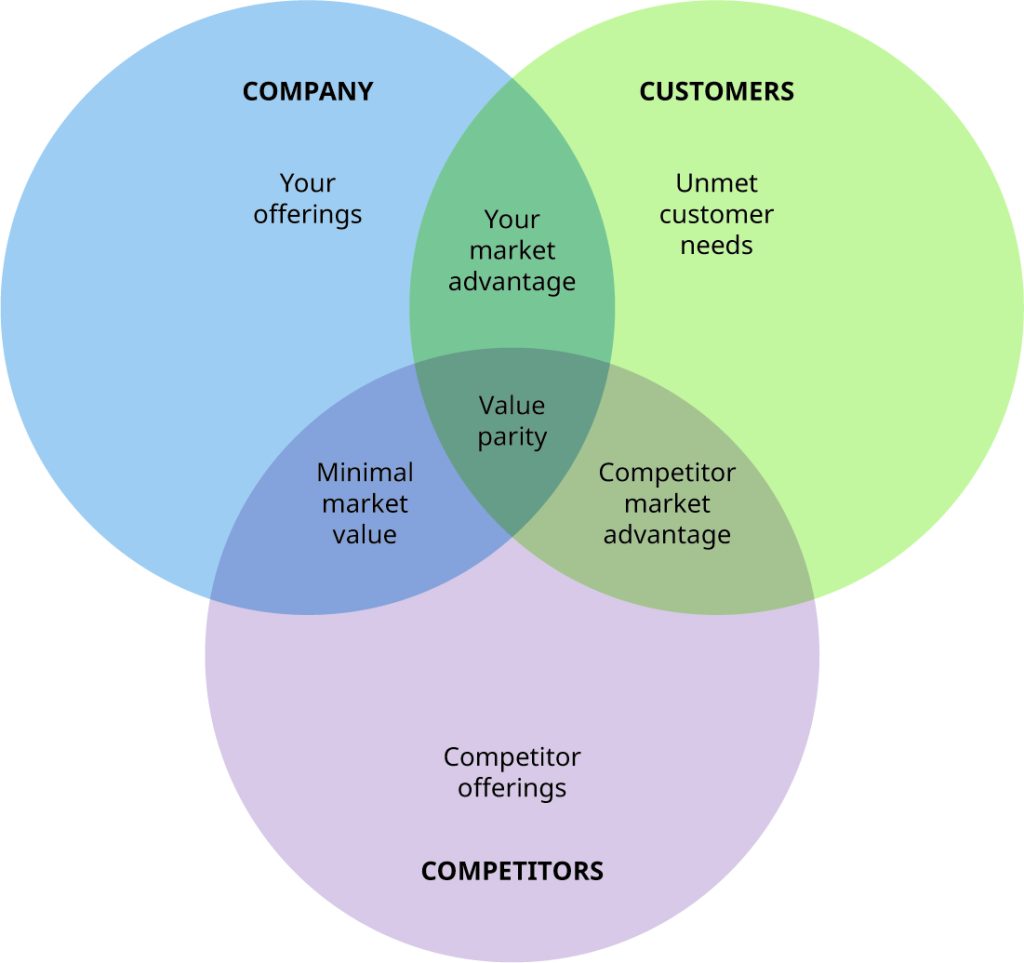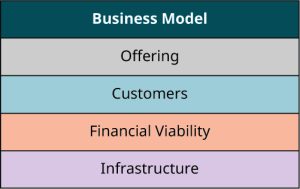3.3 Competitive Analysis
Learning Objectives
By the end of this section, you will be able to:
- Understand the elements of a competitive analysis
- Describe tools you can use to refine and focus your planning (three circles, SWOT, PEST)
- Recognize social media’s role in saving time and money on research
- Understand how a business model helps determine the feasibility of an opportunity
Conducting a competitive analysis helps you focus your idea and identify your unique selling proposition and competitive advantage.
Competitive Analysis
A competitive analysis should provide the entrepreneur with information about how competitors market their business and ways to penetrate the market by entry through product or service gaps in areas that your competitors do not serve or do not serve well. More importantly, competitive analysis helps the entrepreneur develop a competitive edge that will help create a sustainable revenue stream. For example, a big company like Walmart primarily competes on price. Small companies typically cannot compete on price, since the internal efficiencies and volume sales available to large corporations like Walmart are not available to small companies, but they may be able to compete successfully against Walmart on some other important variable such as better service, better-quality products, or unique buying experiences.
When preparing the competitive analysis, be sure to identify your competitors by product line or service segment. For an entrepreneur, this activity can be difficult when the industry does not yet exist. In the case of Bee Love, Palms Barber didn’t have direct competitors, but she did have related competitors of traditional skin care products. Her unique idea of all-natural, honey-based skin care products created a new market. The competitive analysis might need to focus on substitute products rather than direct competitors. There are two main tools used in analysis of competitors: a competitive analysis grid and the “three circles” approach.
Competitive Analysis Grid
The competitive analysis grid should identify your competitors and include an assessment of the key characteristics of the competitive landscape in your industry, including competitive strengths and weaknesses and key success factors. Table 3.2 provides an example of what a competitive analysis might look like for a bicycle shop in a tourist locale.
| Key Characteristics | Sid’s Cycle | City Cycle | SpokeMasters | Target |
|---|---|---|---|---|
| Strengths | Product knowledge, Repair service | Repair service | High quality, Top brands | Price, hours (open seven days per week and online) |
| Weaknesses | Limited selection | Poor customer service | Pricing, no entry-level products | Low-end quality, no repair facilities |
| Product Quality Level | Low-middle | Middle-high | High-end | Entry-level |
| Price Point | Middle | Middle-high | High price | Lowest price |
| Location of the business | Suburban strip-mall on busy highway | Outskirts of town on route 280 | Downtown side street | Branson Mall |
| Promotion | Weekly ad in local newspaper, some radio and Internet/social media | Advertising in local paper during season, Internet/social media | Sponsors major bike race in area, Internet, social media | Advertises online and in Sunday newspaper (seasonally), Internet) |
As you complete an analysis for your venture’s competitors, identify what contributes to the competitor’s success. In other words, why do people purchase from the company? Some possible reasons include no nearby competitors, lower prices than competitors, a wider variety of products, offering services not offered elsewhere, or branding and marketing that appeals to the target market. Your analysis should inform you of a combination of key success factors within the industry (what it takes to be successful in the industry) and of what your competitors are not offering that is valued by your target market.
Another frequently used tool is a SWOT analysis (strengths, weaknesses, opportunities, and threats), which focuses on analyzing your venture’s potential and builds on the knowledge gained from the competitive analysis grid and the three circles. You will need to identify the strengths your venture will need to support the competitive advantage identified through the competitive analysis tools. The weaknesses can be identified based on your current and foreseeable expectations. For a new venture, the opportunities and threats sections are based on current factors in the external environment that come from your research. In this context, opportunities are facts, changes, or situations within the external environment that could be favorably leveraged for the venture’s success.
Work It Out
Using SWOT Analysis to Evaluate Entrepreneurial Opportunity

- One way to evaluate a business idea is to prepare a SWOT analysis (Figure 3.9). Note that strengths and weaknesses are internal to the entrepreneur, while opportunities and threats are external factors. Strengths are capabilities and advantages of the entrepreneur, including education, experience, and personal or professional contacts. Weaknesses are disadvantages of the entrepreneur, which could include lack of knowledge or experience. Opportunities are positive events that the entrepreneur can develop to their benefit. This could include development of new technologies, changes in consumer tastes and preferences, market growth, and new laws and regulations. Threats can be anything that could potentially harm the business or prevent the business from becoming successful such as competition, negative changes in economic conditions, and new laws or regulations.
Questions
- If you were starting a new business venture, what strengths would you be able to leverage to help your business be successful?
- Provide some examples of personal or professional weaknesses an entrepreneur might face when starting a new business.
- Discuss three occurring events such as new laws and regulations, changes in consumer tastes and preferences, or developing new technologies that could provide business opportunity for a new business venture.
PEST Analysis
Another tool that can be used to analyze opportunities and threats section is called PEST analysis (political, economic, societal, technology). In this analysis, we identify issues in each of these categories. Figure 3.10 shows an example of the topics that could be placed in a PEST analysis. The chapter on Fundamentals of Resource Planning discusses this tool as it relates to resource procurement.

Each of these categories should be completed with relevant facts related to your entrepreneurial opportunity. After completing this analysis, you then determine if these facts, or factors, would be placed in the opportunity section or the threat section of the SWOT.
Three Circles Tool
Another tool that can be used in competitive analysis is the three circles tool (Figure 3.11). The goal is to identify competitors’ strengths and competitive advantages with any overlaps among competitors. Then, you would identify values or features not offered by competitors. This gap in value or offered services helps to identify your unique selling proposition and thereby your competitive advantage.

The unique selling proposition is important to the marketing plan and is often used as a slogan. It should also align with the value communicated by the product or company brand. These concepts are different from your venture’s competitive advantage; the competitive advantage describes your venture’s unique benefit, which supports growth of the venture, whereas the unique selling proposition describes the product or service itself, rather than the venture. Although these concepts are different, there should be alignment between the concepts.
For example, Amazon has a competitive advantage in its virtual presence, knowledge of the market, knowledge and application of technology, and knowledge of the industry. Through these competitive advantages, Amazon offers unique combinations of benefits to their customers, such as one-click checkout and algorithm-based recommendations using data mining to track an individual customer’s preferences. Amazon’s unique selling proposition becomes making the purchase as easy and as accurate as possible, whereas their competitive advantage lies in their ability to foresee future advances and act on those predictions, even to the point of shaping the industry.
The competitive advantage results from the analysis of the strengths and unique aspects of a venture, an analysis of the industry, including competitor’s advantages, customer needs, and what the venture provides within this competitive landscape. The unique selling proposition should support the competitive advantage, just as the competitive advantage needs to support the unique selling proposition.
Social Media’s Role in Research
For almost all new business ventures, two key issues related to research are time and money. Large-scale research projects can take months or longer, and cost a significant amount of money. Social media can offer some opportunities to overcome these concerns. Ray Nelson, writing for Social Media Today, reports several ways that social media can provide speedy, low-cost market research: tracking trends in real-time, helping the entrepreneur “learn the language” of their potential customers, discovering unnoticed trends by engaging consumers, and performing market research using a very cost-efficient means.[1] If the entrepreneur can perform social media research on their own, the cost will primarily be in terms of time. But the time it will take to conduct research through social media platforms such as Facebook or Twitter is usually well spent. This research should include learning the unique selling proposition of competitors, understanding their competitive advantage, and identifying what the customer values, which can be rather difficult. For example, before Amazon recognized that people are busy, were we aware that we wanted faster check-out processes for making purchases? Or were we aware that we wanted the package delivered to our home to be easier to unwrap? And yet, if we asked Amazon shoppers what they value in shopping at Amazon, we will receive answers that support an easier and faster process.
Another technique would be to read through customer reviews on Amazon (or another company related to your entrepreneurial venture) to find out what customers like and don’t like about existing products and brands. You can also develop your own surveys on an app like SurveyMonkey and send them to customers and prospective customers. This usually works when sent to persons who have a strong interest in the product or issue rather than randomly sending out surveys.
Business Models and Feasibility
Part of the analysis in determining if your idea is an actual entrepreneurial opportunity is identifying a feasible business model. A business model is a plan for how the venture will be funded; how the venture creates value for its stakeholders, including customers; how the venture’s offerings are made and distributed to the end users; and how income will be generated through this process. Basically, a business model describes how a venture will create a profit by describing each of these actions. The business model at this stage is composed of four components: the offering, customers, infrastructure, and financial viability (Figure 3.12). A fuller version of the business model is covered in Business Model and Plan.

The offering refers to the product or service you will be selling, the value proposition, and how you will reach and communicate with your target customers. The customer value proposition includes a detailed description of the products and services you will offer to customers, and what benefits (value) the customer will derive from using your product or service. The customer benefit could be the ability to do something more easily, more quickly, or at a lower cost than customers could before. The benefit could also solve a problem no one else has solved.
Exercise – Writing a Customer Value Proposition
It is helpful to write out your customer value proposition. Then you have a draft to review and tweak as your ideas develop. Here is a general structure you can follow:[2]
- Start with a headline-style statement that describes how your offering benefits the customer.
- Provide a few sentences or a brief paragraph that explains the offering in more detail. Be sure to make clear what the offering is, who the customer is, and why you are offering it.
- Consider including a bulleted list or checklist highlighting 3–5 features of the product or benefits the customer will receive.
- If possible, add a graphic that engages interest or reinforces the idea.
Customers are the people you will be serving, including potential customers from one or more market segments, or subsections of the market categorized by similar interests or needs. Products seldom appeal to everyone, so the entrepreneur needs to determine, through high-level segmentation and targeting analysis, which segments of the market would make the most sense for the business, and the market environment and dynamics. Some products might appeal to market segments based on age or income, whereas other products might appeal to customers based on their lifestyle. A sign of a potential market opportunity is when a certain market is experiencing rapid growth. This could be a city with a fast-growing population, or it could be a style or consumer trend that is really taking off. The chapter on Entrepreneurial Marketing and Sales goes into more detail about these topics.
Infrastructure refers to all the resources the entrepreneur will need to launch and sustain the business venture. These include people, products, facilities, technology, suppliers, partners, and finances, all of which the entrepreneur must have to fulfill the customer value proposition.
Financial viability relates to the long-term financial sustainability of an organization to fulfill its mission. This goes back to our definition of an entrepreneurial opportunity. Knowing that the venture solves a sizable and significant problem that the target market is willing to purchase is a key piece in determining financial viability. This category also addresses how the venture will create profits.
For example, would a subscription-based business model fit the target market and venture’s success? Currently, we see a significant growth in startups offering subscription services. What are the benefits to this sales method? For the venture, this model increases upfront cash to support the growth of the venture, especially when customers pay a year in advance for products that will be delivered over the subsequent twelve months. Receiving the payment prior to completing the sales provides the venture with operating cash to support current and future growth. The benefit to the customer in this situation is fewer transactions. The customer knows that the payment covers the next twelve months’ worth of benefits (the received product or service) with no further purchases until the subscription runs out.
Another choice involves deciding whether to have a physical location, a virtual location, or both. Financial viability means exploring the benefits and drawbacks of various methods in creating your business model.
Work It Out
Researching Target Markets with Census Data
Practice conducting research by going to Statistics Canada Census Data and two other sources to identify a specific target market for a product that interests you. Include the target market’s:
- Disposable income. You might ask whether the target market has sufficient disposable income to purchase this product.
- Demographics
- Psychographics (the combination of buying personality behaviours and demographics)
- How you as the entrepreneur could reach this target market.
When you have a business idea that you have been researching and find that there is a large enough market that has a need that your idea meets, that this target market has the willingness and ability to satisfy the need through purchasing the provided solution, that you have access to the necessary resources to build an infrastructure for your business, that you have the right mix of products and services with a sound value proposition, and that you can secure funding, you have a real opportunity. This chapter has introduced you to all of these concepts. Further chapters delve into them in more depth.
- Ray Nelson. “How to Use Social Media for Market Research.” Social Media Today. March 19, 2013. https://www.socialmediatoday.com/content/how-use-social-media-market-research ↵
- Modified from Lindsay Kolowich. “How to Write a Great Value Proposition [Infographic].” HubSpot/Marketing. June 5, 2018. https://blog.hubspot.com/marketing/write-value-proposition ↵

